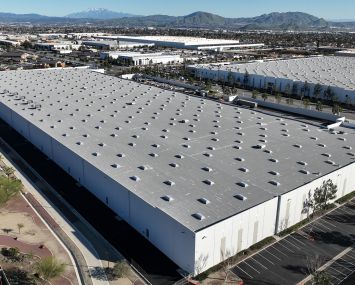Despite Tech Bruising, Data Centers Continue to Boom With No Slowdown in Sight
Regions well beyond the traditional Northern Virginia nexus are vying for new development.
By Patrick Sisson February 22, 2023 11:35 am
reprints
Big Tech may have been bruised and slowed by layoffs and economic challenges. But if the market for data centers — the server-filled structures that form the lifeblood of the internet economy — is any indication, growth is still headed in the right direction.
“In general, demand is stronger than it has ever been,” said Jim Kerrigan, managing principal of North American Data Centers, an industry consultancy.
The market does face significant challenges. A recent cost index report from consultancy Turner & Townsend found margins squeezed by a 15 percent increase in project costs, three-month delays on materials like switchgear, and intense competition for land and resources with similarly booming sectors such as life sciences, battery plants and advanced manufacturing. Still, nobody sees the expansion stopping anytime soon. Developers are scrambling to increase the height and rack density and locate new land. Construction crews can’t keep up.
“We’ve had to push the brakes on doing it all because we just don’t have the construction capacities within our team,” said John Arcello, DPR Construction’s Advanced Technology Core market leader. “It’s not that we’re special. DPR is amongst plenty of others that are doing the same.”
Microsoft has been “out of control,” said Kerrigan, and Oracle, driven by its deal to store data for social media site TikTok, has a voracious appetite for more storage. Cushman & Wakefield predicts the hyperscale market — which supports data center operations and is dominated by Amazon Web Service, Google Cloud and Microsoft Azure — will scale from $173 billion in revenues last year to $728 billion in 2027, even amid electricity price spikes, including the 16 percent cost increase anticipated this past year. Artificial intelligence (AI) adoption across tech will require new sites with faster processors, which developers are already planning for in future builds.
“The last few years have been the perfect storm for the data center sector,” said Joseph Connolly, North America Data Center lead at Turner & Townsend. “We haven’t seen a slowdown in demand from hyperscalers, and a pickup in demand from colocation sites. People are being more selective about business cases and business expenses. We’re moving into AI, and who knows what they’ll develop over the next couple of years. It’s going to continue to require more data.”
Take Northern Virginia, the birthplace of the modern data center market and currently the globe’s biggest data center hub. Tech firms such as Microsoft, Facebook and Yahoo started leasing data center space there in 2007. The hypergrowth of hyperscalers, such as the Big Tech firms, has led to 1 percent vacancies in the region, increased pushback from local residents, and new development that has literally tapped out certain subregions’ electrical grids. Local utility Dominion Energy stated it’ll be suffering significant power constraints in Loudoun County until new infrastructure goes online in 2026, and won’t be able to deliver the power they promised.
At the same time, nearby submarkets such as Prince William and Culpeper counties are angling to pick up the slack, and Amazon in January signed a $35 billion contract to build new data centers across Virginia, a deal so sizable a detractor disappointed at the incentives being thrown at the tech giant said, “We might as well start calling it the Commonwealth of Amazon.”
Even with those power issues, companies are still making deals in Loudoun to seize space and opportunity for when the grid is upgraded. Buddy Rizer, Loudoun County’s executive director for economic development, told Datacenter Dynamics, a news site, that the Dominion news “hasn’t paused any of the demand for the land. People are still trying to secure long runways so that when the power is here, they’ll be able to really move pretty quickly. Nothing has slowed down the demand on our land.” In this region, nicknamed Data Center Alley, land is still moving at $1 million to $3 million an acre.
The appetite for more data for everything from 5G to social media to cloud storage, and the demands placed on the grid in leading markets, means rapid expansion into new areas. These include Portland, Ore., where Kansas-based data center developer QTS is currently building a 250-megawatt site for Meta. The Northwest hub now ties Northern Virginia for potential, according to some analysts, especially as the market leader proves to be a more challenging business climate. The areas around Chicago and Atlanta are also becoming major hubs, with clients pushing past the coasts and toward the interior to find cheap land with good transportation links and connections to the energy and fiber grid, as well as a low propensity for natural disasters.
Turner & Townsend’s Connolly said Dallas, Phoenix and Columbus, Ohio, in particular have seen unprecedented growth in the last 12 months — with Phoenix boasting of more than 300 megawatts under development. Jacob Albers, a Cushman & Wakefield research manager, highlighted patterns of expansion in Salt Lake City, Austin and San Antonio, too. As the fiber grid expands, new markets and real estate speculation will follow, with investors seeking to shore up space and seize as much power supply as possible.
Some clients are even asking for gargantuan, 100-megawatt campuses, and many are rushing to prelease to lock down space. (DPR’s Arcello said whereas firms used to reserve space six months in advance, they’re now signing leases 18 to 24 months in advance.) Currently, 30 states offer some kind of incentive to attract new sites.
“Land is becoming one of the largest constraints because a lot of these developments require large acreage that satisfies fiber connectivity and power connectivity,” said Albers. “And not only is there a lot of competition between different data center providers, but often there’s competition from other asset classes to capture these sort of large parcels in key suburban or rural submarkets.”
The rush has also brought in multi-billion-dollar mergers and significant new investments from deep-pocketed investors, especially at a time when real estate funds are de-emphasizing retail and office. Last year saw $48 billion in data center mergers and acquisitions activity overall, according to Data Center Frontier. DigitalBridge and IFM Investors in December finished an $11 billion acquisition of data center firm Switch, while data center developer CyrusOne sold for $15 billion to investment firms KKR and Global Infrastructure Partners. This kind of activity should continue apace in 2023, analysts say.
The rapid expansion of data centers, and the voracious demand for electricity to run these facilities, has made sustainability and better emissions reporting key agenda items within the industry. Albers predicts that in some of the largest markets there will be tightness in terms of grid availability, with occasional pauses in development due to high electricity demand.
In the short term, more developers have focused on carbon offsets to hit ESG, emissions reduction and net-zero targets. Increasingly, though, clients are looking at making designs more sustainable from the outset, as well as procuring and generating their own sustainable power on site. There’s even a push to design hydrogen fuel cell technology and small nuclear reactors to help handle the industry’s gargantuan energy requirements, said Arcello.
Focusing on building efficiency first, and cooling requirements, especially with the vast amount of resources needed for water-cooled facilities, is key, said Breana Wheeler, operations director at BREEAM, which analyzes building sustainability. There are also data centers now that are a decade or older that can be rehabbed, allowing more efficiency within an already built shell. It’s frankly an all-of-the-above hyperspeed approach to figure out how to continue to power, and profit from, this industry.
“One of the things that’s exciting about data centers as a sector of real estate is that just by its nature it’s quite a bit more innovative,” said Wheeler. “Real estate is often accused of acting slowly. I don’t see any real players in the space not considering these things and these challenges. They also have the procurement pull, and to be able to engage with at the utility level, to drive these kinds of changes.”


